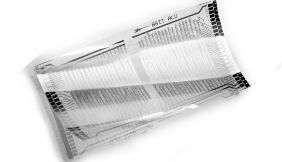World’s first fully organic microprocessor demonstrated
on

Imec, the Holst Centre and TNO, in collaboration with Polymer Vision, have demonstrated the world’s first working 8-bit organic microprocessor, fabricated by depositing 4,000 organic transistors directly on a flexible plastic film. Using an inexpensive organic (plastic) material instead of expensive silicon opens the door to new niche applications that need inexpensive processing power, such as smart packaging that can be discarded after use, and flexible applications such as roll-up display screens and smart fabrics.
The organic microprocessor consists of two thin films with a thickness of 25 µm. One of them holds the arithmetic logic unit, with 3,381 transistors covering an area of 1.96 by 1.72 cm, while the other holds the instruction code, with 612 transistors covering an area of 0.72 by 0.64 cm. The circuits were fabricated by depositing alternating layers of organic material (pentacene and insulators) and metal (for interconnects) on a flexible substrate. The microprocessor operates with a supply voltage between 10 and 20 V at a maximum clock frequency of 6 Hz. The typical power consumption with a 10 V supply voltage is 92 µW.
Although the new organic microprocessor is presently the slowest microprocessor in the world, it represents enormous progress, like the Intel 4004 at its time. When Intel launched their first 4-bit silicon microprocessor (the Intel 4004) in 1971, it had 2,300 transistors and was able to perform simple calculations. At that time nobody expected it to herald the start of the digital era. Now Intel makes 64-bit processors with billions of transistors, which can perform complex operations at lightning-fast speeds with relatively low power consumption.
It is unlikely that organic microprocessors will cause a comparable revolution, but the demonstration of the first organic microprocessor shows that inexpensive organic circuits can be a real alternative to expensive silicon devices in a number of applications. Organic circuits will never be able to outperform conventional semiconductors in terms of speed or processing power, but they have many other advantages. They are flexible, and they can be applied to a very large surface easily and expensively.
Applications with microprocessors printed directly on packaging materials, in the same way as labelling or advertising, are directly possible. In the longer term, potential applications of inexpensive, flexible organic microprocessors include smart packaging for medicinal products that indicates when you should take your medicine, and packaging that allows you to check authenticity or freshness. A box of biscuits from the supermarket could tell you how many biscuits you have already taken, and accordingly how many calories you have consumed.
Image: Imec


Discussion (0 comments)